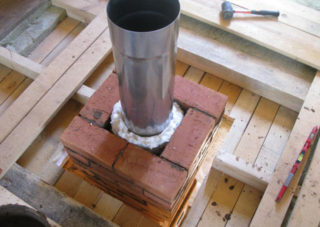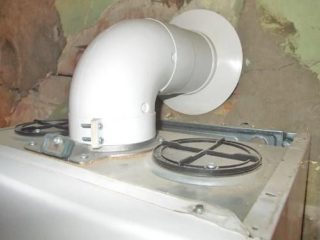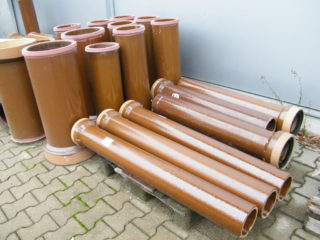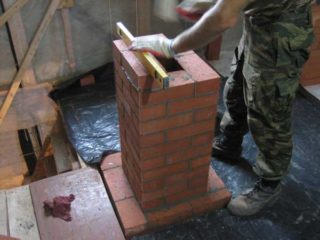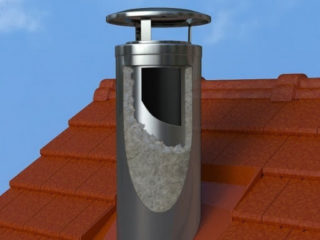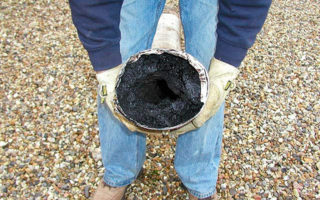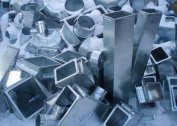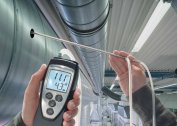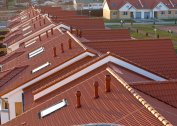The chimney in a private house is an integral part of the heating and water heating system. These designs provide the output of combustion products from fireplaces, columns, gas and solid fuel stoves, which are installed in residential buildings, garages, bathhouses and other outbuildings. The combustion rate of the fuel, the draft in the furnace, and the safety of the building and its owners depend on the correct assembly of the structure. A wide range of products of this type is on sale. Possessing construction skills, it will not be difficult to make a chimney with your own hands. To do this, you need to familiarize yourself with the device of these structures and the principles of their assembly.
Chimney requirements
The rules for the construction and operation of systems for the removal of combustion products are prescribed in SNiP 2.04.05–91 and SNiP 41-01-2003. Their compliance with the planning and implementation of installation is one of the conditions for putting the facility into operation. Arrangement of the structure is a multi-stage process, which involves raising it from the bottom up, the competent execution of joints and passage through the supporting structures.
The correct chimney must meet the following requirements:
- minimum channel length - 500 cm;
- pipe clearance - not less than the size of the outlet pipe;
- maximum number of knees (turns) - 3;
- horizontal runs up to 200 cm;
- gas velocity along the channel - 15-20 m / s;
- the height of the niche for cleaning and collecting condensate - from 25 cm;
- height above a flat roof - 50 cm;
- height above the ridge - 50 cm or flush if the exit is more than 250 cm from its level;
- the radius of the curve is greater than the cross section of the channel;
- minimum design temperature - 1000º.
It is forbidden to combine the outputs from several boilers in one channel. It is not allowed to connect chimney and ventilation pipes together.
Chimney construction
In order to assemble the gas removal system from the stove without problems, you should understand its design and principle of operation. The efficiency and safety of the entire heating system depends on the correct design and consideration of all the nuances.
Standard chimney device:
- Boiler. It has a firebox, a device for adjusting the intensity of combustion, a branch pipe for exhausting gases leaves the body. A pipe is connected to it.
- The channel itself. Depending on the laying conditions, it can be strictly vertical or have turns. These fragments correspond to the parameters of the main channel.
- Fluff. They are extensions that are made at the places where the pipe intersects the ceilings and the roof. Flares are equipped with insulating material.
- Heading. It is a protective device against water, snow, debris and small animals getting into the pipes.
- Chimney mount. By type of use, it is carried out on walls and on the roof to withstand strong wind loads and wet snow sliding down.
Each structural element performs a specific function and requires careful study during planning.
Material selection
The right choice of materials is one of the components of the quality of construction. Each of them has its advantages and disadvantages, cost and durability. When making a decision, you should carefully consider all aspects and not miss a single nuance.
The pipe from the boiler can be made of such materials:
- Brick.Blocks are characterized by fire resistance, heat capacity and durability. They can even be put on a cast-iron boiler operating on coal. On this, the advantages of brick end. There are many more disadvantages - the design is very heavy. A rectangular lumen can form internal turbulences. The walls are porous and rough, soot accumulates more intensively on them. Water absorbs the surface, and when it freezes in the cold, it breaks it.
- Iron. The use of circular pipes is the optimal solution. The chimney from a metal pipe can be quickly and easily assembled using bells or welding. Steel has sufficient strength. However, ferrous iron is subject to corrosion, and the acids formed inside the channel quickly corrode it.
- Asbestos cement. Inexpensive material from which it is easy to assemble a direct chimney. The difficulty lies in sealing joints, for which it is difficult to choose a sealant with the desired characteristics. In addition, the asbestos-cement channel inside is porous, soot quickly accumulates on its surface.
- Ceramics. An excellent solution for those who have sufficient funds for an expensive purchase. The ceramics are durable, heat-resistant, and soot does not settle on smooth internal walls.
- Tin with insulation (sandwich). The presence of filler between the pipes eliminates the dew point and prevents condensation. The product does not need to be additionally insulated, soot inside accumulates extremely slowly.
Chimneys need to be assembled from one material, since each of them has its own coefficient of thermal expansion.
Step-by-step instructions and the nuances of installing yourself
To achieve a qualitative result, at the first stage of construction, a chimney scheme is drawn up and the necessary calculations are made.
The hardest thing to build a canal of brick. The process is long, difficult, requiring breaks, so that the masonry shrinks. If the chimney is light, it is placed on top of the stove. When the structure passes through several floors, it is placed next to the furnace and connected with an adapter.
A chimney made of brick with your own hands is done in the following sequence:
- The manufacture of the solution. Clay, lime and cement are used.
- Laying out the base with the binding of each row.
- The output of the inner pipe with a hole for the damper.
- The passage of the ceiling, the manufacture of fluff.
- Laying out the external channel, arrangement of the second extension (otter).
In conclusion, cracks are closed and the head is installed.
It is much easier to assemble ceramic chimneys. The assembly uses ready-made elements that need to be connected, sealed and securely fastened. The work is carried out in the following sequence:
- The manufacture of a refractory base with a pipe.
- Phased installation of the pipeline in the bell. At the same time, the joints are sealed with heat-resistant sealant.
- Fastening the highway to the walls and attic structures.
- Application of thermal insulation.
- Installation of external decoration, installation of head.
During the construction of ceramics, it is necessary to observe the general rules for chimneys - install inspection hatches, condensate collectors, and the protection of floors with a special apron.
Sandwich type pipelines are also made from prefabricated links that are inserted one into the other.
The assembly of the chimney from the stainless steel is carried out in the following order:
- Making the base with a pipe.
- Assembly of the highway with simultaneous isolation of junction points. A sealant or clay-soaked asbestos cord is used.
- Laying a chimney through a wall or ceiling.
- Fixing communication to the walls and roof.
- Setting the head.
Having built a chimney with your own hands from an iron pipe with a heater, you can not worry about its additional decoration.The product does not actually heat up; it can be laid through a wooden ceiling without mounting an apron.
Chimney operation and cleaning
With proper operation, chimneys can serve for decades without accidents and repairs. The rules for servicing the device are quite simple. They should be inspected regularly for damage and cleaned regularly. In winter, it is necessary to drain the condensate more often to prevent it from freezing.
To avoid the rapid formation of soot, it is recommended to use high-quality and dry fuel. In this case, you should not raise the temperature in the furnace to critical, as this negatively affects the pipe.
The chimney is cleaned from a wood boiler as it becomes soiled, but at least once a year. The following methods are used:
- Mechanical. The case is a ruff with a load, on a cable or a rigid handle.
- Thermal. Sludge is destroyed by burning aspen wood, which produces intense heat during combustion.
- Chemical. Synthetic or organic ingredients are added to the fuel, which turn soot into dust or liquid substance.
To achieve the best result, it is advisable to arrange preventive cleanings every month with regular use of the oven.
